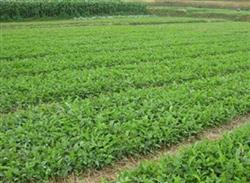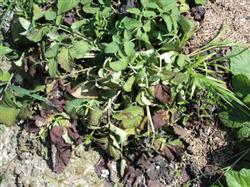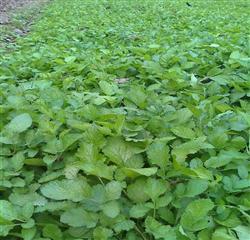How to raise seedlings and propagate Salvia miltiorrhiza?

How to raise seedlings and propagate Salvia miltiorrhiza? Please introduce several propagation methods of Salvia miltiorrhiza, such as seed seedling method, plant division method, root division method and cutting method, etc. The root-splitting method is mainly used in production, and this method can greatly increase the output. (1) split root method: select a new root with a diameter of 0.7-1.0 cm, which is robust and disease-free, and cut it into small segments 5-7 cm long. Land preparation for border ditching, border width of 1-2 meters, unlimited length, ditch depth of 20 cm, border surface must be flat. Make a ditch of 3mi 4cm long on the border surface, with a depth of 30cm. Put the root segment 20 cm apart and cover the bottom of the trench to flat. Or the root section obliquely arranged on the ditch wall, can also be placed directly on the ditch wall, (can not be inverted) finally covered with soil 7 cm, forming a small ridge. The planting time is around the Beginning of Winter (mid-November) after the harvest of Salvia miltiorrhiza. Seedlings emerged one after another in the spring of the following year, so they bloomed late and could not even get seeds, but the roots of Salvia miltiorrhiza planted by this method grew faster and could effectively increase the yield. In order to make Salvia miltiorrhiza early, plastic film mulching and plastic sheds (large, medium and small) can be used for overwintering management in production practice, which can make Salvia miltiorrhiza develop early in spring, make full use of light resources and increase yield. (2) seed propagation: first harvest the seeds of Salvia miltiorrhiza, use the seeds to raise seedlings, and then transplant in the field. This method has the advantages of low production cost and rich provenance, so it can be used in large area production. The specific operations are as follows: in order to improve the germination rate, Salvia miltiorrhiza can be sown immediately after seed collection, and different seedling raising periods can also be selected according to crop stubble and local climatic conditions: after the Qingming Festival in the Central Plains, White Dew can raise seedlings in bare land before April to October, and greenhouse or greenhouse can be used in winter or early spring. The dry seed weight of Salvia miltiorrhiza seed is only 1.2 grams, and the general germination rate is 70%. Better seedling effect can be obtained when sowing within one year, but it is still best used in the year of seed collection. The seedling bed of Salvia miltiorrhiza seedlings requires higher topography, loose soil, fertile soil, convenient watering and drainage, and slightly shading conditions are more favorable for seedling emergence. First of all, the seedbed should be fertilized, ploughed, raked, flattened, and scraped. The width of the bed is about 1.5 meters. Radix Salviae Miltiorrhizae is generally sown by sowing, but also by strip sowing. After the seeds are spread evenly, you don't have to cover the soil, use your feet again, and let the seeds stick to the soil. The upper straw must be sprinkled after sowing to protect against the sun. Sprinkle water frequently after sowing to keep the surface and soil layer wet. If the seeds are sown in June, the seedlings will emerge in about 10 days, and the straw on the soil surface should be removed in time. After emergence, the grass should be pulled in time, and when the seedlings have 5 true leaves, the seedlings should be interspersed. The seedlings can also be transplanted and cultivated in other plots. After the seedlings, but also timely watering, and topdressing once, in order to facilitate the growth of seedlings. Transplanting can be carried out two and a half months after sowing. The standard seedling is about 7ml 10cm in length of main root, about 7mm in thickness, and 13cm in leaf length. Most of the transplanting time is from late October to early November, which takes root and survives in that year, and blossoms in the second year. According to experience, Salvia miltiorrhiza should be transplanted earlier, because of early transplanting and early rooting. When the cold winter comes, it has already survived and has a certain resistance, which is conducive to early green next year. Try not to postpone transplanting until the cold season. The transplanting density of Salvia miltiorrhiza seedlings. It is also more flexible, depending on the land and fertilizer conditions, and the commonly used plant spacing is 20cm × 25cm, 25cm × 30cm and so on. When transplanting, it is necessary to open a hole, which depends on the situation of the seedling, and the heart bud shall prevail after burying the soil. Don't go too deep, and don't expose your roots. After burying the soil, we should be steadfast in time and water the roots. (3) Reed head division method: when Salvia miltiorrhiza was harvested, the sturdy and pest-free plants were selected and the thick roots were cut off for medicinal use. Leave the roots thinner than cigarettes, together with heart leaves and Reed heads (where the roots and stems are connected) as seedlings for planting. The larger Reed head can be divided into 4 plants according to the natural growth of buds and roots before planting, so as to improve the propagation coefficient. The transplant density is the same as that of seed seedling transplantation. The transplant time can be carried out in late autumn and early spring. (4) the method of cutting propagation: the purpose of propagation can also be achieved by using the stem cuttings of Salvia miltiorrhiza. The specific method of operation is to cut the stem segments evenly, each section with axillary buds and stem nodes, and watering in time after insertion to maintain humidity until survival. Click to get more planting techniques of Salvia miltiorrhiza
- Prev

How to prevent and cure root rot of Salvia miltiorrhiza?
How to prevent and cure root rot of Salvia miltiorrhiza? Please introduce Salvia miltiorrhiza root rot: first, harmful symptoms: Salvia miltiorrhiza root rot occurs in the high temperature and rainy season, harming the roots of the plant. At the initial stage, only a few roots or part of the underground rhizome became ill first, and gradually expanded to the whole root system. Wet rot occurs after the root is killed, and the skin is black.
- Next

How to grow Radix Salviae Miltiorrhizae?
How to grow Radix Salviae Miltiorrhizae? How many planting methods are there for Salvia miltiorrhiza? Salvia miltiorrhiza is a perennial herb salvia miltiorrhiza (SaLviamiltiorrhiza,Bge) of Labiatae. Xi said: blood ginseng, purple salvia miltiorrhiza, red root and so on. Salvia miltiorrhiza has strong adaptability, like warm, moist, sunny environment, cold tolerance, shade tolerance, etc.
Related
- Fuxing push coffee new agricultural production and marketing class: lack of small-scale processing plants
- Jujube rice field leisure farm deep ploughing Yilan for five years to create a space for organic food and play
- Nongyu Farm-A trial of organic papaya for brave women with advanced technology
- Four points for attention in the prevention and control of diseases and insect pests of edible fungi
- How to add nutrient solution to Edible Fungi
- Is there any good way to control edible fungus mites?
- Open Inoculation Technology of Edible Fungi
- Is there any clever way to use fertilizer for edible fungus in winter?
- What agents are used to kill the pathogens of edible fungi in the mushroom shed?
- Rapid drying of Edible Fungi

